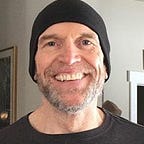Knowledge, Conviction, and Belief [5]
My soul is lost, my friend
Tell me how do I begin again?
My city’s in ruins,
My city’s in ruins.
- Bruce Springsteen
Neuroscience looks for the soul in the brain and can’t find it. What it finds instead are the elements of consciousness — sensory perception, language, cognition, memory, etc. — in various neural networks and regions of the brain, and those diverse networks collaborating to generate a composite conscious experience. Meanwhile, the master network — the one that is equivalent to conventional notions of the soul or self — remains elusive.
Prof. Bruce Hood lays out the progression from conventional belief in a separate self to the current brain network theory:
“Psychologist Susan Blackmore makes the point that the word “illusion” does not mean that it does not exist — rather an illusion is not what it seems. We all certainly experience some form of self, but what we experience is a powerful deception generated by our brains for our own benefit.
“Understanding that the self could be an illusion is really difficult… Our self seems so convincing, so real to us. But then again, many aspects of our experience are not what they seem.
“In challenging what is the self, what most people think is the self must first be considered. If you were to ask the average person in the street about their self, they would most likely describe the individual who inhabits their body. They believe they are more than just their bodies. Their bodies are something their selves control. When we look in the mirror, we regard the body as a vessel we occupy.
“This sense that we are individual inside bodies is sometimes called the ‘ego theory,’ although philosopher Gale Strawson captures it poetically in what he calls the ‘pearl view’ of the self. The pearl view is the common notion that our self is an essential entity at the core of our existence that holds steady throughout our life. The ego experiences life as a conscious, thinking person with a unique historical background that defines who he or she is. This is the ‘I’ that looks back in the bathroom mirror and reflects who is the ‘me.’
“In contrast to this ego view, there is an alternative version of the self, based on the ‘bundle theory’ after the Scottish Enlightenment philosopher David Hume… He tried to describe his inner self and thought that there was no single entity, but rather bundles of sensations, perceptions and thoughts piled on top of each other. He concluded that the self emerged out of the bundling together of these experiences.
“If the self is the sum of our thoughts and actions, then the first inescapable fact is that these depend on brains. Thoughts and actions are not exclusively the brain because we are always thinking about and acting upon things in the world with our bodies, but the brain is primarily responsible for coordinating these activities. In effect, we are our brains or at least, the brain is the most critical body part when it comes to who we are.
“There is no center in the brain where the self is constructed. The brain has many distributed jobs. It processes incoming information from the external world into meaningful patterns that are interpreted and stored for future reference. It generates different levels and types of motivations that are the human drives, emotions, and feelings. It produces all sorts of behavior — some of them automatic while other are acquired thought skill, practice, and sheer effort.
“The sense of self that most of us experience is not to be found in any one area. Rather it emerges out of the orchestra of different brain processes.”
The Self Illusion: How the Social Brain Creates Identity, Bruce Hood (2012)
Princeton neuroscientist Michael Graziano uses an “attention schema theory” to describe this collaboration of neural networks. “The heart of the theory is that awareness is a schematized, descriptive model of attention,” he says, and expands as follows:
“In the present theory, the content of consciousness, the stuff in the conscious mind, is distributed over a large set of brain areas, areas that encode vision, emotion, language, action plans, and so on. The full set of information that is present in consciousness at any one time has been called the ‘global workspace.’ In the present theory, the global workspace spans many diverse areas of the brain. But the specific property of awareness, the essence of awareness added to the global workspace, is constructed by an expert system in a limited part of the brain…. The computed property of awareness can be bound to the larger whole… One could think of awareness as information.”
Consciousness and the Social Brain. Michael S. A. Graziano (2013)
To those who hold fast to the common belief (as most people do) that the soul is something transcendent, noble, unique, special, poetic, and divine, referring to consciousness and the self as “global workspace” and calling awareness “information” lacks a little something. But is that any reason to reject the bundle theory as untrue?
Meanwhile, Prof. Graziano admits that “the attention schema theory does not even seek to answer the question of existential reality but instead tries to describe what is constructed by the brain.” And besides, is science really after truth anyway?
We’ll look at those questions next time.
Originally published at http://iconoclast.blog on October 11, 2019.
